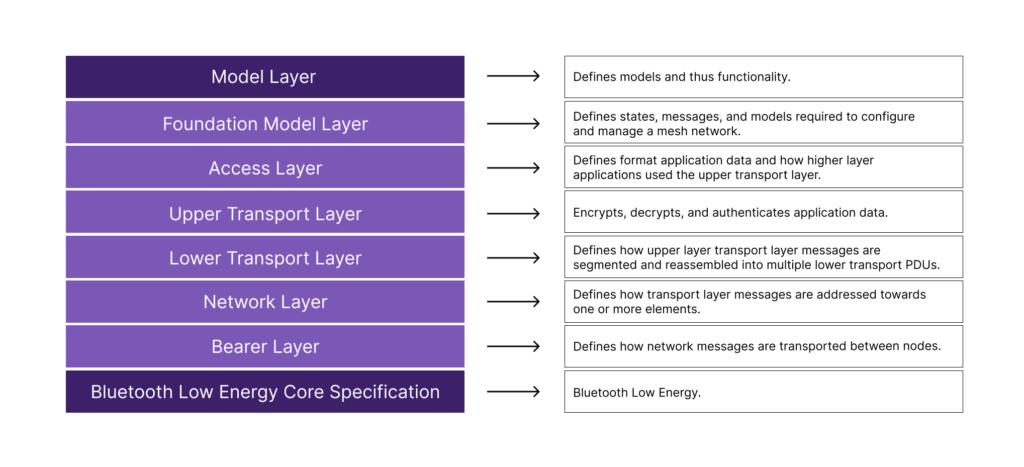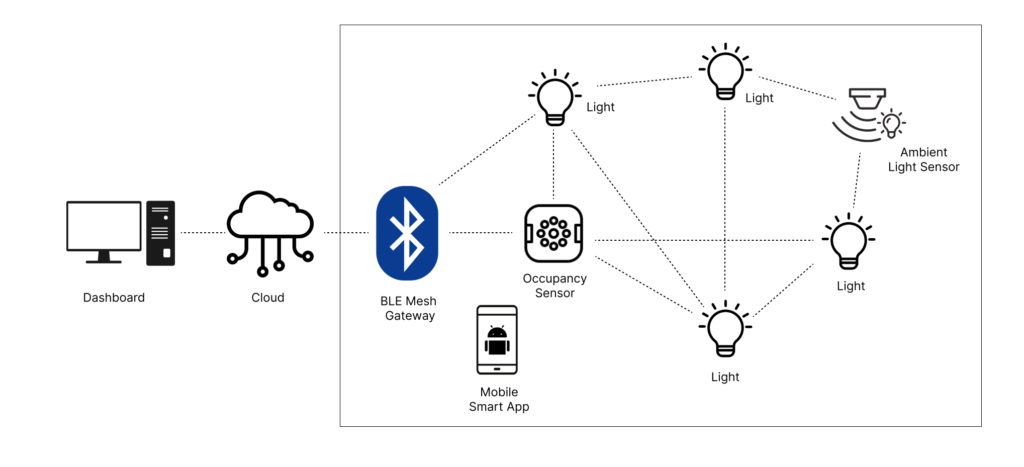Wireless Lighting Control
Wireless lighting control has witnessed a surge in popularity in commercial settings, thanks to its myriad benefits over traditional wired systems. Leveraging cutting-edge Bluetooth technology, these devices enable seamless control and management of lighting infrastructures resulting in enhanced flexibility, cost savings, energy efficiency, superior control, and an elevated user experience. As technology continues to advance, wireless lighting control systems, particularly those powered by Bluetooth Mesh, are poised to become even more sophisticated, offering an array of additional advantages for the commercial sector.
Bluetooth Mesh, a wireless communication protocol, has played a pivotal role in transforming commercial lighting applications. By facilitating robust and scalable networking of devices, Bluetooth Mesh enables the formation of a mesh network (which has been popularized by other powerful communication protocols like in ZigBee and ZWave) that ensures efficient data transmission. This technology has ushered in a new era of advanced features in commercial lighting, including human-centric lighting, daylight harvesting, and occupancy-based lighting.
With their expansive coverage area, wireless lighting control systems are perfectly suited for large-scale commercial spaces such as shopping centers, office buildings, warehouses, hospitals, parking areas, and educational facilities. These systems empower users to create customized ambiences while reaping significant energy savings, making them an intelligent choice for building owners and managers.
Bluetooth Mesh
But what exactly is wireless lighting control, and how does Bluetooth Mesh make it possible? In essence, Bluetooth Mesh is an advanced network protocol widely recognized for its great fit for commercial lighting control. Leveraging Bluetooth Low Energy (BLE), this protocol enables multiple Bluetooth devices to communicate with each other in a mesh topology. In such a network, all devices can send and receive messages, fostering a robust and scalable infrastructure. The reliability, scalability, and security offered by Bluetooth Mesh make it an ideal fit for commercial applications.

Mesh Network
At the core of every mesh network lies the node entity. Bluetooth mesh nodes communicate with one another using packets, which are essentially messages flooded throughout the network. These messages can be commands or reports and are not intended for continuous data streaming. The inclusion of relay nodes ensures rapid message propagation and extends the network’s coverage area.
Provisioning, the process of integrating a device into the network as an addressable node, is typically achieved through a smartphone or tablet app. With up to 32,767 nodes supported in a single network, Bluetooth Mesh provides ample scalability for diverse commercial environments.

Encryption & Security
Security is a paramount concern for Bluetooth Mesh, which is why industrial-grade security practices are integral to the protocol. From the provisioning process itself, all traffic is encrypted, and the transmission of unencrypted messages is strictly prohibited. Message integrity checks are applied across multiple networking layers, and a triple key mechanism (device, network, and application) ensures node and data authentication. The protocol employs sophisticated obfuscation, end-to-end encryption procedures, key refresh mechanisms, blacklisting, and message sequencing techniques to minimize security threats.
A Bluetooth Mesh lighting control system encompasses a networked environment where Bluetooth signals enable communication and control among various smart lighting components, including fixtures, switches, sensors, and controllers. This allows users to effortlessly control multiple luminaires without the need for physical wiring between each fixture. The network can be managed via a smartphone or web-based dashboard, offering intuitive access to lighting operations, scheduling, scene management, brightness adjustment, and more. The versatility and user-friendly interfaces provided by these control systems ensure a seamless and optimized lighting experience.

Advantages of Bluetooth Mesh
One of the key advantages of using a wireless mesh network for lighting control is the elimination of wiring requirements, making it particularly suitable for retrofit projects in existing buildings. The ability to scale the network by adding more devices as needed further enhances flexibility and adaptability, critical factors in dynamic commercial spaces.
Various devices can connect through a well-functioning lighting control network, including motion and light sensors, dimmers, wireless switches, LED drivers and fixtures, bridges, luminaire controllers, and gateways that allow connection to existing building management systems.
These devices work together to provide the necessary functionality for effective remote control over daylight harvesting strategies, occupancy sensing and energy-saving scenarios within a given space.
Benefits of Bluetooth Mesh Lighting Control for Commercial Applications
Intelligent wireless lighting control systems offer a multitude of advantages for commercial settings, particularly when compared to traditional wired systems. With the power of Bluetooth Mesh technology, these systems revolutionize the way lighting is controlled and managed, delivering exceptional results in terms of ease of installation, energy efficiency, customization, and integration with building management systems.
Ease of Installation
One of the key benefits of wireless lighting control, leveraging Bluetooth Mesh, is the simplicity of installation. Unlike traditional wired systems, wireless lighting control eliminates the need for extensive wiring infrastructure. This streamlined approach significantly simplifies and accelerates the installation process. By leveraging existing infrastructure without major modifications, wireless lighting control becomes an ideal choice for retrofit projects, reducing disruptions and costs.
Energy Efficiency
Energy efficiency is another major advantage of wireless smart lighting control systems. Through advanced features such as occupancy sensing, daylight harvesting, and scheduling, these systems contribute significantly to energy savings and sustainability goals. By intelligently managing lighting usage, they effectively reduce energy consumption, lower carbon footprint, and align with green building practices.
Ease of Integration
Wireless lighting controls offer a multitude of benefits for commercial applications, including ease of installation, energy efficiency, and customization. They can be seamlessly integrated with building management systems, enabling advanced energy monitoring and reporting. This integration facilitates the identification of areas where energy savings can be maximized. Wireless lighting control systems can also harmoniously integrate with other smart building systems like HVAC, security, and energy management, enabling coordinated and centralized control, data exchange, and energy optimization across various building systems. This results in enhanced overall efficiency and operational effectiveness.
Mobile App Based Control
With smartphone apps or web interfaces, wireless lighting control systems provide a high level of control and fixture light customization. Users can easily set up desired lighting levels, create schedules and scenes, and even design custom lighting effects. This flexibility is invaluable for creating specific ambiences in commercial spaces and highlighting key areas or products.
Extensive Coverage
Moreover, these systems offer extensive coverage, making them ideal for large-scale commercial spaces, including shopping centers, office buildings, warehouses, hospitals, parking areas, and educational facilities. By combining the creation of a desired ambiance with energy savings, wireless lighting control systems become the intelligent choice for building owners and managers.
Bluetooth Mesh networked lighting control systems empower commercial applications with unparalleled benefits. From simplified installation to energy efficiency, customization, and seamless integration with building management systems, these systems offer a holistic solution for enhanced lighting control in commercial environments. With wide coverage and the ability to create unique ambiences, wireless lighting control systems elevate the lighting experience while delivering significant energy savings, making them the smart choice for building owners and managers.
Written by Anil Kumar, Tech Lead – Embedded Engineering Thingularity